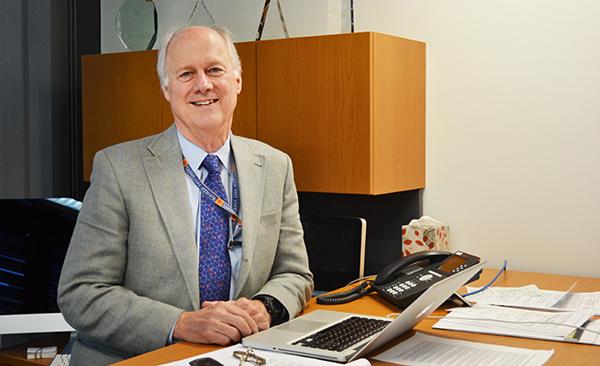
Updated: Sept. 4, 2014 at 5:27 p.m.
A former Centers for Disease Control and Prevention official spent the summer planning how to build the University’s $30 million research institute that focuses on childhood obesity.
Bill Dietz, director of the Sumner M. Redstone Global Center for Prevention and Wellness, has pinpointed three research projects that will explore childhood wellness and guide the center’s launch over the next year. Those plans could bring him to D.C. public schools to evaluate how effectively laws like the Healthy Schools Act, which expanded school meal options, have helped curb childhood obesity.
Dietz led the CDC’s nutrition and obesity network for more than 15 years. He said he envisions the center looking at how certain cities have lowered childhood obesity rates, and he will recruit professors to compare efforts in communities across the nation.
That D.C. project, which Dietz said is still in the early phases of planning, will likely analyze how physical activity and nutrition can have an effect in early education centers. In 2012, 14.9 percent of the city’s children between 2 and 5 years old were overweight, while 13.7 percent were obese, according to data from the CDC.
“This ties back to beginning to understand what works,” Dietz said “I’ve been meeting with people in the city to begin to understand their interest in partaking in this effort, and the school is poised to do this.”
Dietz said current research on obesity is largely fractured and incomplete because most is conducted at a local level, rather than through a broader, cross-community lens.
“The challenge is that the physical activity people don’t overlap with the people who promote breastfeeding or the fruit and vegetable intake people. So how we begin to align groups and messages and strategies will be part of the challenge,” Dietz said.
The University hired Dietz to lead the center last spring after philanthropist Sumner Redstone made a $30 million donation for the creation of an obesity and wellness research center. He said he is forming advisory boards made up of the school’s faculty and outside experts to help guide the center over the next few months, and one of those groups will meet for the first time in about two weeks.
Dietz joined GW after billionaire philanthropists Redstone and Michael Milken gave a combined $80 million donation to the public health school, which was renamed the Milken Institute School of Public Health just as it moved into a new, glassy building on Washington Circle.
The building, which cost $75 million, was designed to promote exercise and healthy lifestyles. Faculty have standing desks, and the first-floor elevators are hidden behind a wall while a large staircase winds through the center of the building.
Dietz said the school would likely recruit faculty to specifically affiliate with the center if their research lines up with its interests. As the University has planned more interdisciplinary research centers, professors have wondered how they will recruit faculty who are typically affiliated with a specific department.
Rajiv Rimal, chair of the department of prevention and community health, said the research center would allow GW to look into issues surrounding obesity more extensively.
“It is going to really allow us to bring faculty from outside, but also from within GW and the School of Public Health or even across colleges, and put everybody under the same roof so that issues around nutrition and obesity are covered,” he said.
Dean Lynn Goldman said last year that she planned for the center to help get “risky research” off the ground, since the multi-million dollar donation would give researchers an opportunity to look for new projects. Dietz said he was interested in launching a pilot study through the center, though he did not know the topic.
Douglas Evans, a professor of prevention, community and global health, said the study could present ways for younger researchers to stand out early in their careers.
“Both for more senior people like myself, but also and maybe even more for younger faculty to get involved in pilot projects, get some initial data they can use, get papers published. I think it will be especially helpful to mentor and grow the careers of younger faculty,” Evans said.






